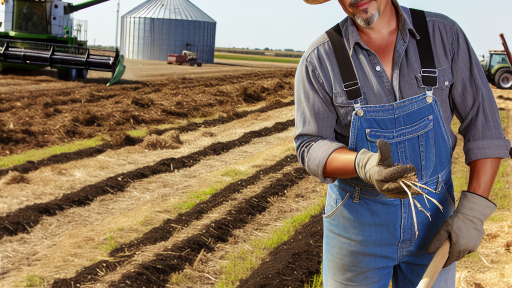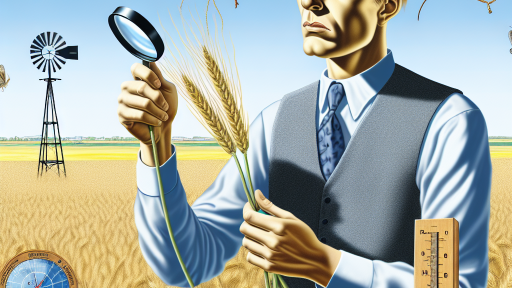Introduction to Hydroponic Farming and Its Benefits
Hydroponic farming is a modern method of growing plants without soil.
It utilizes nutrient-rich water to nourish plants directly.
This technique offers many advantages for growers and consumers alike.
Efficiency in Space Utilization
Hydroponics maximizes space efficiency significantly.
It allows for vertical farming, which preserves land usage.
Growers can cultivate more crops in smaller areas.
Consequently, this method is ideal for urban environments.
Faster Growth Rates
Plants grown hydroponically typically exhibit faster growth rates.
This occurs due to direct access to nutrients and water.
As a result, harvests can occur multiple times per year.
Faster growth translates to increased productivity and profits.
Reduced Need for Pesticides
Hydroponic systems can help reduce pesticide usage significantly.
Without soil, many pests and diseases are less prevalent.
This approach promotes healthier produce for consumers.
Water Efficiency
Hydroponics uses significantly less water than traditional farming.
Transform Your Agribusiness
Unlock your farm's potential with expert advice tailored to your needs. Get actionable steps that drive real results.
Get StartedThis method recirculates water, minimizing waste.
In fact, hydroponic systems can save up to 90% of water usage.
Thus, they are more sustainable in water-scarce regions.
Quality of Produce
Hydroponics can lead to higher quality produce.
Due to controlled growing environments, plants thrive consistently.
This results in fresher, tastier fruits and vegetables.
Moreover, hydroponically grown produce often contains more nutrients.
Accessibility and Year-Round Production
Hydroponic farming allows for year-round cultivation.
Growers can achieve consistent production regardless of seasons.
This increases food availability in various regions.
Consequently, it meets consumer demand more efficiently.
Key Factors Affecting Plant Growth in Hydroponics
Light Intensity
Light plays a crucial role in plant growth.
It drives photosynthesis, ensuring plants produce energy.
The right light intensity promotes healthy development.
Using LED lights can optimize light levels effectively.
Tailoring the light spectrum enhances specific growth stages.
Nutrient Solutions
Hydroponics relies on nutrient solutions for plants.
These solutions contain essential elements for growth.
Balancing nutrients, such as nitrogen and phosphorus, is vital.
Regular monitoring prevents deficiencies and toxicities.
Adjusting pH levels also enhances nutrient absorption.
Temperature Control
Maintaining the right temperature is essential for plant health.
Optimal temperatures vary between plant species.
High temperatures can stress plants and affect yields.
Showcase Your Farming Business
Publish your professional farming services profile on our blog for a one-time fee of $200 and reach a dedicated audience of farmers and agribusiness owners.
Publish Your ProfileConversely, low temperatures may stunt growth significantly.
Investing in heating and cooling systems promotes stability.
Water Quality
Water is central to hydroponic systems.
Quality water ensures proper nutrient delivery.
Using filtered water prevents harmful contaminants.
Regular testing of water quality maintains system balance.
Salinity levels should also be monitored closely.
Oxygen Levels
Oxygen availability impacts root health significantly.
Roots require oxygen for effective nutrient uptake.
Implementing air stones can improve oxygen levels in the solution.
Good aeration promotes robust root growth in hydroponics.
Monitoring dissolved oxygen levels is essential for success.
System Maintenance
Regular maintenance keeps hydroponic systems functioning optimally.
Cleaning components prevents algae and pathogen buildup.
Inspecting pumps and valves ensures efficient water flow.
Timely replacement of worn-out parts maintains system integrity.
Following a maintenance schedule can enhance productivity.
Top Leafy Greens for Hydroponic Systems
Lettuce
Lettuce is one of the most popular hydroponic crops.
It thrives in various hydroponic systems, like NFT and DWC.
This leafy green grows quickly under optimal conditions.
Furthermore, it offers a refreshing taste and crisp texture.
There are many lettuce varieties suited for hydroponics.
- Butterhead lettuce is tender and sweet.
- Romaine lettuce provides a crunchy bite.
- Leaf lettuce is colorful and versatile.
Spinach
Spinach is another excellent choice for hydroponic gardening.
This nutrient-dense green is packed with vitamins.
Hydroponically grown spinach matures rapidly.
Additionally, it adapts well to various nutrient solutions.
Many growers appreciate its flavor and health benefits.
- It can thrive in both deep water and nutrient film techniques.
- Young spinach leaves are perfect for salads and smoothies.
- Mature leaves work well in cooked dishes.
Kale
Kale is gaining popularity among hydroponic enthusiasts.
This superfood is rich in antioxidants and vitamins.
It grows well in diverse hydroponic setups.
Kale plants can yield a bountiful harvest.
Furthermore, they can be harvested multiple times throughout their lifecycle.
- Curly kale has a robust texture and flavor.
- Lacinato kale offers a unique, flat leaf shape.
- Red Russian kale adds color and sweetness to dishes.
See Related Content: Essential Techniques for Improving Soil Health
Fruit-Bearing Plants Suited for Hydroponics
Tomatoes
Tomatoes thrive remarkably well in hydroponic systems.
They require consistent moisture and nutrients for optimal growth.
Hydroponics helps control the environment, promoting robust fruit development.
Moreover, they can grow year-round in a controlled setting.
Popular varieties include Roma, Cherry, and Beefsteak tomatoes.
Cucumbers
Cucumbers also adapt well to hydroponic systems.
They flourish in nutrient-rich water with plenty of light.
Showcase Your Farming Business
Publish your professional farming services profile on our blog for a one-time fee of $200 and reach a dedicated audience of farmers and agribusiness owners.
Publish Your ProfileThese plants can produce high yields in minimal space.
Cucumbers need support as they grow, making trellising essential.
Choose varieties like Marketmore or English cucumbers for the best results.
Peppers
Hydroponics offers an excellent growth medium for peppers.
They thrive with warm temperatures and bright light.
Furthermore, peppers can be grown in various hydroponic setups.
Options include bell peppers, jalapeños, and habaneros.
Harvesting can occur throughout the growing season.
You Might Also Like: Practical Mulching Tips for Effective Crop Management
Herbs that Thrive in Hydroponic Environments
Basil
Basil is a popular herb for hydroponic farming.
Its fast growth and vibrant flavor make it a favorite among growers.
This herb thrives in nutrient-rich water solutions.
Moreover, basil has a low light requirement which simplifies cultivation.
Attention to humidity helps enhance its flavor profile.
- Grow basil in temperatures between 70°F and 85°F.
- Maintain a pH level around 5.5 to 6.5 for optimal growth.
- Provide at least 12-16 hours of light each day.
Mint
Mint is another excellent choice for hydroponic systems.
This herb offers a refreshing flavor and aroma.
It tends to grow vigorously, so it’s vital to manage its spread.
The plant enjoys cooler temperatures, ideally between 60°F and 70°F.
Mint can thrive in various hydroponic setups, including NFT and deep water culture.
- Use a slightly acidic pH level, around 6.0 to 6.5.
- Ensure adequate airflow to prevent mold growth.
- Keep water well-oxygenated for healthy root development.
Cilantro
Cilantro is a favored herb in many culinary dishes.
It grows well in hydroponic environments with moderate temperatures.
This plant prefers temperatures around 60°F to 75°F.
Cilantro also thrives in cooler conditions compared to other herbs.
Its unique flavor is sought after in various cuisines worldwide.
- Keep the nutrient solution pH between 6.0 and 7.0.
- Provide 10-12 hours of light daily.
- Harvest cilantro regularly to encourage bushier growth.
Find Out More: Role Of Weather Data In Pest And Disease Forecasting

Choosing the Right Hydroponic System for Different Plants
Understanding Hydroponic Systems
Hydroponic systems vary widely in design and function.
Each type offers unique benefits for specific plants.
Common systems include Nutrient Film Technique, Deep Water Culture, and Ebb and Flow.
Understanding these systems helps gardeners make informed choices.
Factors to Consider When Choosing a System
Several factors influence the choice of hydroponic system.
The type of plants being grown plays a crucial role.
Space availability also determines the best system.
Additionally, the gardener’s experience level matters significantly.
Best Plants for Nutrient Film Technique
Nutrient Film Technique works well for fast-growing plants.
Lettuce and herbs thrive in this system.
These plants require constant nutrient access and drain easily.
Consider growing basil and cilantro for excellent results.
Choosing Deep Water Culture for Large Plants
Deep Water Culture suits larger, heavier plants.
Tomatoes and peppers flourish in this setup.
This system offers maximum oxygenation for robust growth.
Showcase Your Farming Business
Publish your professional farming services profile on our blog for a one-time fee of $200 and reach a dedicated audience of farmers and agribusiness owners.
Publish Your ProfileConsequently, plants develop strong root systems.
Benefits of Ebb and Flow Systems
Ebb and Flow systems provide versatility for various plants.
This method is ideal for a range of fruits and vegetables.
Grow cucumbers or beans for abundant yields.
Thus, it allows benefits from both flooding and draining.
Considering Climate and Light Conditions
The local climate significantly influences system choice.
Some plants require specific light conditions for growth.
Grow lights may be necessary for low-light environments.
Understanding the light needs helps select the right setup.
Experimenting with Different Systems
Many gardeners find success through experimentation.
Trying multiple systems can reveal what works best.
Observe growth patterns to adjust systems accordingly.
Ultimately, adapt the hydroponic setup to suit specific plants.
Discover More: Data Driven Decisions For Optimal Crop Cultivation
Common Challenges and Solutions in Hydroponic Plant Cultivation
Understanding Environmental Conditions
Hydroponic farming requires precise environmental control.
Temperature fluctuations can affect plant growth.
Humidity levels also play a vital role in health.
Managing these factors ensures optimal conditions.
Employing climate control systems mitigates this challenge.
Nutrient Management
Providing the right nutrients can be tricky in hydroponics.
Imbalances may lead to nutrient deficiencies or toxicity.
Regularly testing nutrient solutions helps maintain balance.
Utilizing pre-mixed nutrient solutions simplifies the process.
Pest and Disease Control
Pest infestations and diseases can devastate hydroponic systems.
Regular monitoring of plants is essential.
Implementing Integrated Pest Management (IPM) strategies is effective.
Biological controls can also reduce pest populations.
System Design and Maintenance
The design of the hydroponic system significantly impacts performance.
Poor design may lead to water stagnation or oxygen depletion.
Regular maintenance of equipment prevents system failures.
Maintaining clear communications with suppliers ensures parts availability.
Knowledge and Skill Acquisition
Hydroponic farming requires specific knowledge and skills.
Farmers new to hydroponics may find the learning curve steep.
Participating in workshops can enhance understanding.
Connecting with experienced growers often provides valuable insights.
Future Trends in Hydroponic Farming and Plant Selection
Emerging Technologies in Hydroponics
Advancements in technology significantly influence hydroponic farming.
Automated systems enhance efficiency and reduce labor costs.
Using sensors helps monitor nutrient levels and plant health.
Moreover, artificial intelligence can optimize growing conditions.
This shift toward technology-driven farming supports precision agriculture.
Showcase Your Farming Business
Publish your professional farming services profile on our blog for a one-time fee of $200 and reach a dedicated audience of farmers and agribusiness owners.
Publish Your ProfileShift Towards Sustainable Practices
Sustainability is becoming a priority in hydroponic farming.
Growers aim to reduce water usage and energy consumption.
Environmental concerns drive the use of organic nutrient solutions.
In addition, crop rotation practices enhance soil health and productivity.
Hydroponic farms are increasingly integrating renewable energy sources.
Popular Plant Choices for Hydroponics
Hydroponics supports a diverse range of crops.
Leafy greens are particularly popular due to their fast growth rates.
- Lettuce
- Spinach
- Kale
Herbs also thrive in hydroponic systems.
- Basil
- Mint
- Cilantro
Furthermore, tomatoes and peppers have gained traction among growers.
These plants adapt well to hydroponic methods and yield high returns.
Consumer Trends Influencing Plant Selection
Consumer preferences shape the future of hydroponic farming.
There is a growing demand for organic produce in urban areas.
Local sourcing appeals to health-conscious consumers.
Many people prefer fresh, chemical-free vegetables and herbs.
This trend encourages hydroponic farms to focus on high-quality crops.
Future Innovations in Plant Breeding
The future of hydroponic farming includes innovative plant breeding techniques.
Cultivating varieties that are specifically adapted to hydroponics is gaining attention.
Genetic modification and selective breeding create disease-resistant plants.
These advancements can lead to higher yields in controlled environments.
Additionally, breeding for flavor and nutritional value supports consumer demand.
Additional Resources
Vertical Farming – No Longer A Futuristic Concept : USDA ARS




